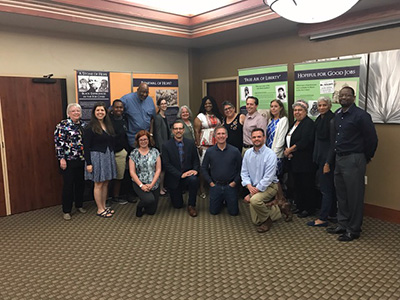January 2, 2022
By Donna K. Sack, Vice President and Chief Program Officer, Naper Settlement, and Unvarnished Project Director; and Susie Wilkening, Principal Wilkening Consulting and Unvarnished Project Research


Bottom: Dr. Fiona Vernal-Wright shares the history of housing segregation in Hartford, CT with the Unvarnished project team in October 2019. (Photo courtesy of Naper Settlement)
Unvarnished is a journey of six organizations coming together as a learning cohort to shed light on histories of systemic racism in their communities, as evidenced by real estate and sundown town practices.
Funded by an IMLS National Leadership Grants for Museums award to Naper Settlement in 2017, our project’s process and findings are not only a model for the field, but also produced a virtual exhibit, Unvarnished: Housing Discrimination in the Northern and Western United States and an accompanying teacher guide and curricula that will be released this spring.
As part of this project, we also fielded considerable research on audience attitudes to inclusive history, including with educators. As our society has become increasingly polarized, history and social studies teachers are finding themselves in the crosshairs. How and what they teach is being questioned and, in many states, legislated, often making history the most contentious subject taught in school. For educators already struggling with the daily rigors of the classroom amid a pandemic, this additional scrutiny is exacerbating stress levels.
To understand their challenges and needs, we conducted two phases of research: a national survey of 5,020 educators and in-depth qualitative research with 121 educators. We found three essential ways that history organizations could help educators:
- Historical Advocacy Tools. Educators want tools from history organizations to back up their work in the classroom. Things requested included: online history resources; position statements on major areas of contention; form letters and pamphlets for parents and caregivers; blurbs for school newsletters; and advocacy materials for administration, school boards, legislatures, and standards/textbook commissions.
-
I do find having resources from "acclaimed" sources like museums, teaching websites, or historical sites, is helpful because it gives me something to fall back on if parents or students do have questions, and something I could show my administration. —Pennsylvania high school teacher
-
- Professional Development. Educators want opportunities to help them become more effective history advocates, build their inclusive confidence, and give them strategies and tactics for the classroom.
-
I think also trainings focused specifically on those "hard" histories moments. I would feel more confident teaching certain topics if I had more knowledge and information on those topics. —South Carolina middle school teacher
-
- Emotional Support. Underlying so much of what educators shared was the stress and toll the challenges of teaching history today is taking on educators. They asked for coaching and counseling, as well as peer support groups focused on their specific needs as history educators.
-
I would say that we could all use more social/emotional support, especially in current times. I believe programs connecting teachers with one another and with museum educators would be a valuable resource. —North Carolina middle school teacher
-
All of this underscores the primary need: engaging children with the past by sharing a whole and accurate history of our country. To accomplish that goal, we must take care of the educators themselves by partnering with them to provide the professional support they need and as individual people navigating the classroom. This is a moment to forge stronger ties between museums, schools, and our communities.
Naper Settlement is an outdoor history museum in Naperville, Illinois, which features 13 acres of learning and interactive opportunities for all ages.